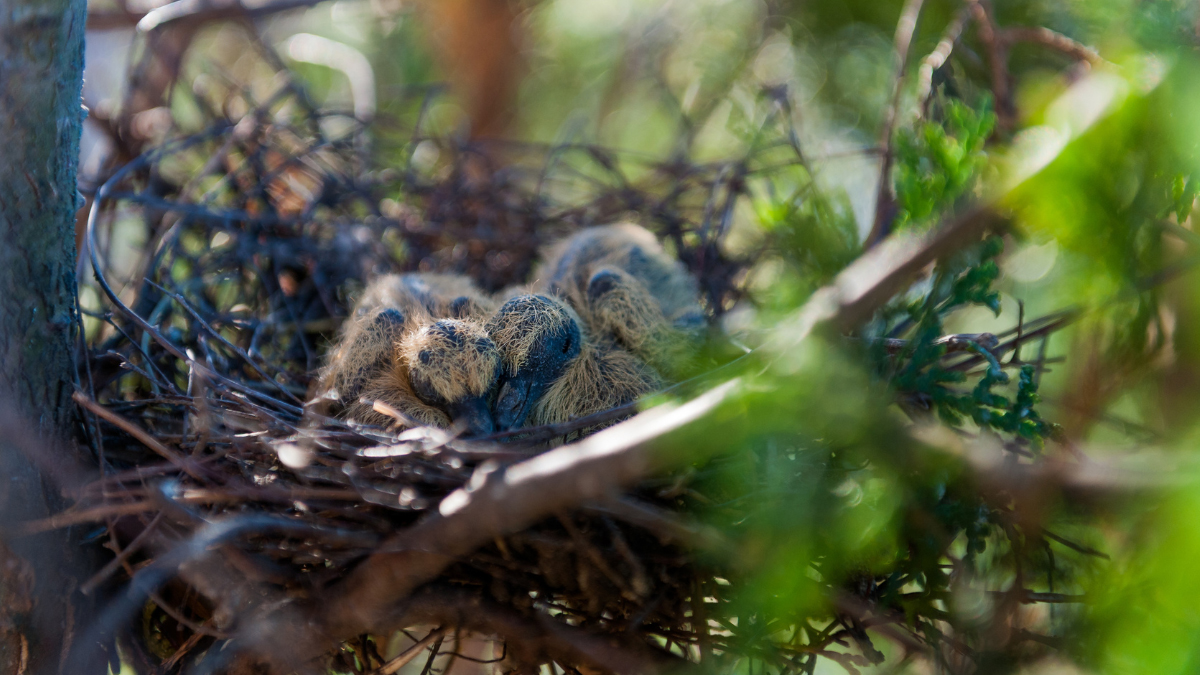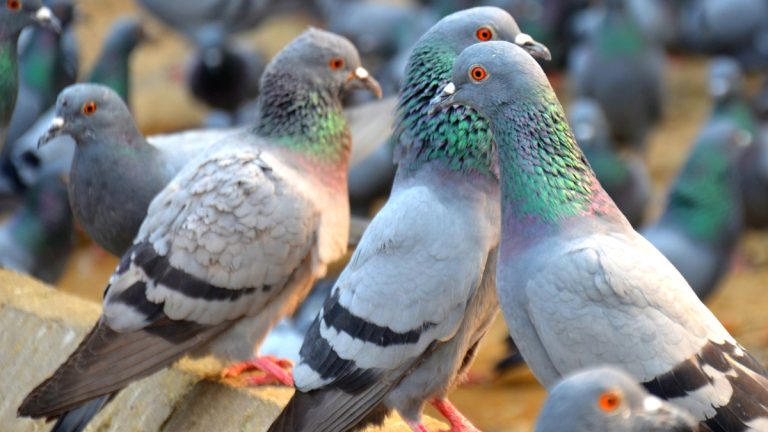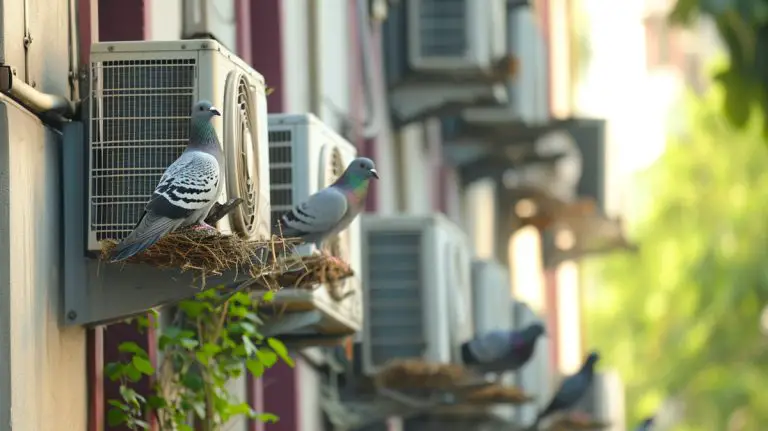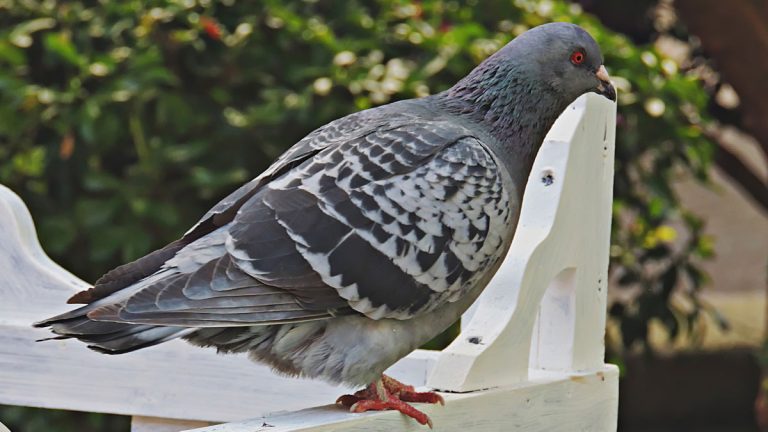The Pigeon’s Distinctive Nesting Habits and Materials
Pigeons, sometimes known as rock doves or rock pigeons, are recognized for their homing and messaging abilities. But that’s not the unique thing about them. They also entail unusual nesting habits that are essential to their reproduction.
Firstly, pigeons need a secure, sheltered place to lay eggs and breed. Secondly, they can make their home (nest) from different plant material, twigs, and grass and upkeep it for life. And it is fascinating that they mate for life and stay loyal to each other. Owing to the solid parental instincts of both males and females, they take care of their eggs and chicks equally.
If you are a pigeon enthusiast, scholar, or student, understanding their nesting habits will give you awareness of avian ecology research. Moreover, you can also leverage the pigeon’s nesting instincts to unveil the vital principles of bird behavior and adaptation. And best of all, you will develop an appreciation for pigeons after understanding their nesting habits.
From discussing the nesting materials and behaviors of the nesting challenges in urban areas, we will discuss all ins and outs of pigeon nesting habits and materials. So let’s get to it!
Nesting Habit of Pigeons
As with every other animal’s nesting habit, pigeons must also nest in tranquil locations to increase their breeding success. For that, there are a few attributes that pigeons depict while nesting. But before discussing nesting, lets talk about the Pigeon breeding pairs:
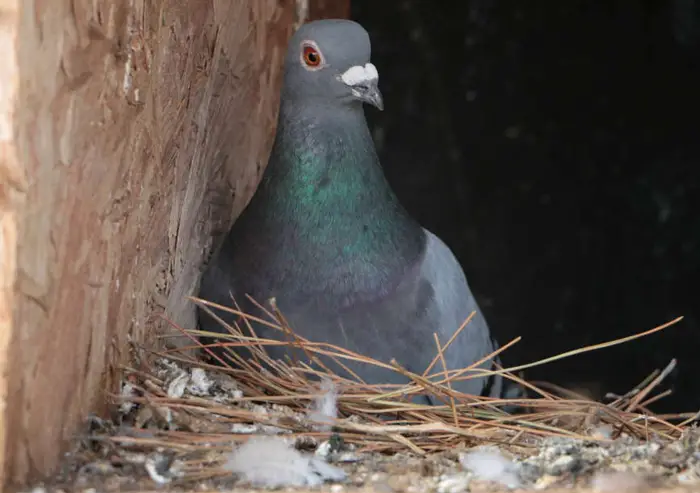
Pigeon Breeding Pairs
Do you know that Pigeons are monogamous birds, implying they stay loyal to their partner for their entire life or during the breeding season? After finding the mate, the pigeons will start mating during the spring and summer.
To lure the mate for breeding, the pigeon will make gestures such as cooing, puffing feathers, and bobbing its head.
After finding the perfect mate, the couple will make a perfect nest site selection.
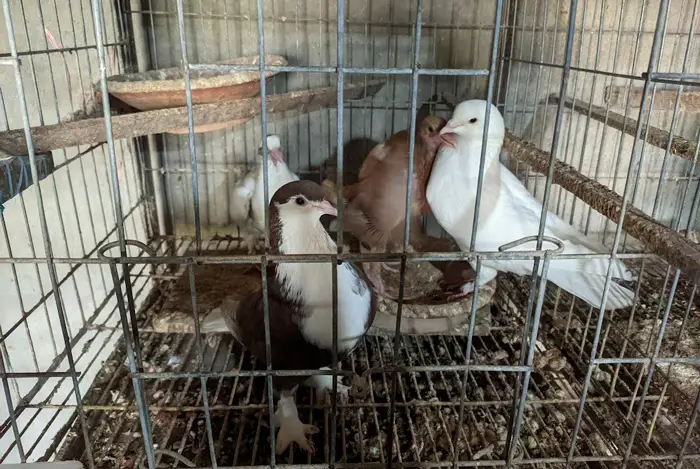
Location of the Nest
When it comes to Pigeon nesting sites, pigeons are very demanding towards them. They prefer nesting at flat and safe places (both from weather and predators). You will often see pigeons nesting at building ledges, trees, house windows, or rooftops. There are a few reasons why they prefer flat surfaces for nesting, that are:
- They get a stable and level place for hatching eggs.
- Maintaining a nest on a flat surface is easy.
- They can keep an eye out for predators because of a clear view of the surroundings.
- In urban areas, flat surfaces are abundant, unlike in rural areas where natural shelters are plentiful.
Note that pigeons are intelligent creatures who show a particular behavior for making a home. Moreover, this bird can remember nest site locations for a lifetime, which is why they return to their nest even after years. After choosing their safe and comfy spot for a home, the pigeons begin to make the nest.
Hatching Eggs
Pigeons are responsible parents since they take care of everything from laying eggs to their babies’ first flight. Once they get eggs in the nest, they will make all the parental investments, and for that, both parents take turns incubating and keeping the eggs warm.

Raising Squabs
Moreover, after eggs hatch, they continue to care for their young and fragile squabs. You might not know, but pigeons feed their young milk. While it is not precisely milk but rather a milk-like substance known as “crop milk.”
Both male and female pigeons can produce it as it is formed in their crops. This milk is essential for the squabs because it is plentiful in protein, fat and essential nutrients. After their fragile babies grow up a bit, this gradually transits them from crop milk to regurgitated food.
Besides feeding, they also start to teach their babies to fly and hunt for food. And when they see that their once fragile squabs are now mature pigeons, they cheer them on to explore the world alone.
Nesting Materials of Pigeons
When it comes to making nests, pigeons can use a variety of materials, from grass and twigs to straws and other vegetation. However, they never choose nesting material randomly; instead, they pick stuff that provides comfort and safety to the eggs and hatchlings.
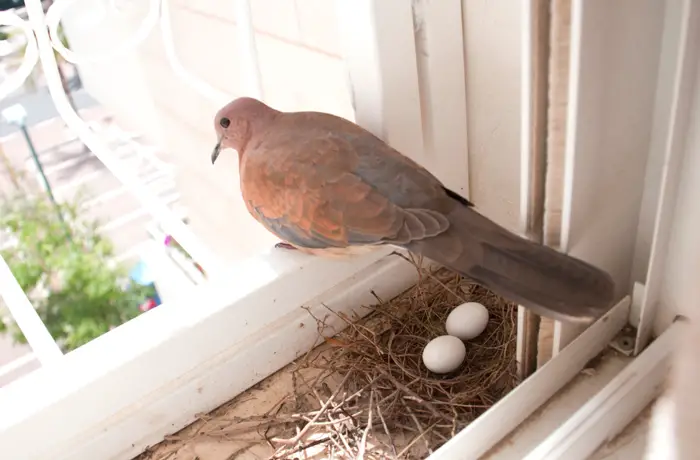
Moreover, another fantastic thing is that pigeons distribute the workload equally, wherein males bring the nesting material and females make a nest from them.
The Ways Pigeons Consider Collect Nesting Materials
If we speak of their material choice for nesting, there are a few factors that influence them, such as:
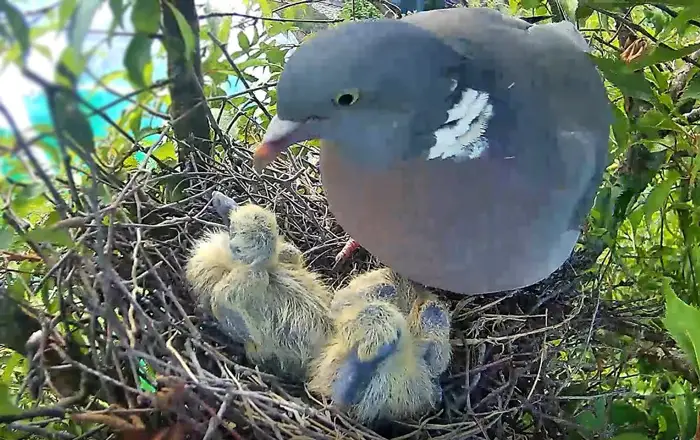
Accessibility: Mainly, pigeons collect things that are easily accessible such as straws, grasses, and twigs. But sometimes, they can also go for man-made stuff like strings, cloth pieces, etc. However, they mostly prefer natural materials for their safety, but if they can’t find such stuff in urban areas, they go for artificial stuff.
Attracting Mate: Pigeons also choose nesting material to attract their mate or gain dominance over others. If a pigeon has other pigeons in the surroundings, they will choose the nest material to have the edge over the others. They might incorporate bright things in their nest to allure the mate.
Comfort and Safety: Pigeons choose a material that is comfortable for their eggs and chicks to increase pigeon breeding success. Soft, pliable materials such as leaves and straws are preferred since they provide cushy protection to the eggs and hatchlings. Besides that, they are very protective of their newborns, so they avoid plastic and metal.
Nesting Materials and Avian Ecology
While nesting material is important for breeding success, it also impacts avian ecology.
For instance, due to increasing pollution and natural vegetation scarcity, pigeons find it challenging to find suitable stuff for nests. Result? Poor pigeon breeding will lead to the pigeon population’s endangerment.
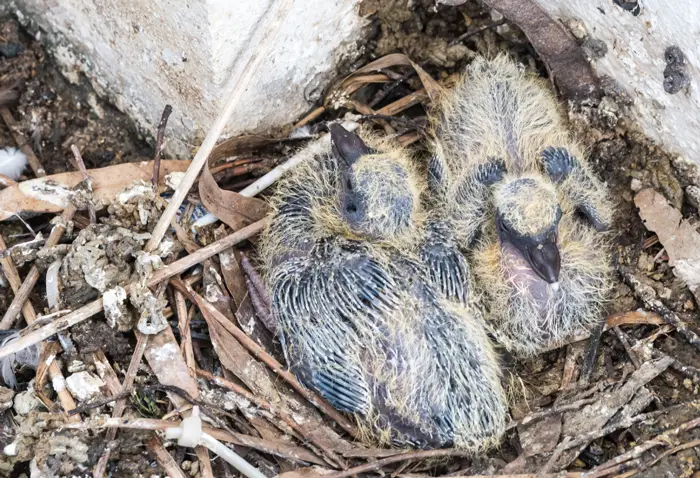
However, many pigeons have evolved with time and now leverage human-made stuff like paper, plastic straws, etc., for their nests. But it is not suitable for their health and the environment. Why?
Because plastic and other synthetic materials house a lot of harmful chemicals that are equally harmful to humans and birds. When pigeons use synthetic stuff for their nest chances are that pigeons or their young can absorb it. And upon absorbing these chemicals, they may encounter health issues such as hormonal imbalances, reproductive problems, and even death.
In fact, nesting materials for the pigeon’s dwelling are equally important for their pigeon breeding ecology and breeding success. So it is essential to ensure that pigeons get appropriate nesting materials for their homes.
The Significance of Pigeon Nesting Behavior
We can never overstate the significance of the pigeons’ nesting behaviors. Moreover, understanding nesting habits help make effective animal reproductive strategies which leads to more breeding success.
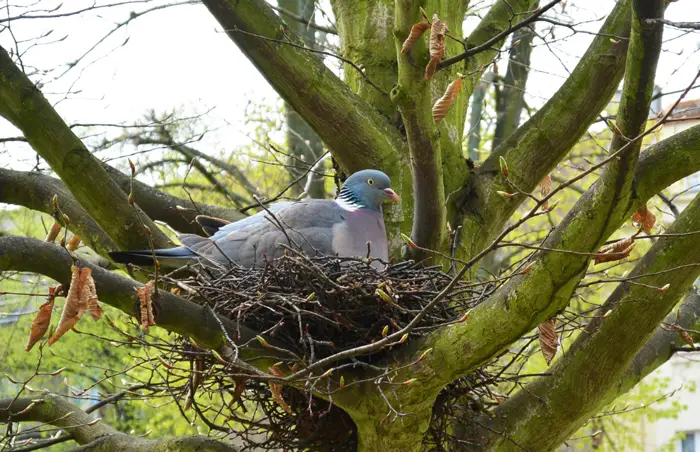
But why does pigeons’ nesting behavior matter so much? Pigeon nesting behavior and things matter significantly to avian ecology since they affect urban and natural environments. Here are some of the ways it does so:
- Reproduction: Since pigeons depend on their nest for reproduction and breeding, you can’t deny its importance. Not paying attention to their nest will lead to population endangerment.
- Habitat: As mentioned earlier, most pigeons have adapted to the urban area. They represent a unique part of the urban ecological system. They help pollinate and spread seeds that help bridge the urban ecosystem gap.
- Food chain: You already know that pigeons are prey and food for predators in the wild. Raptors, snakes, and other birds, like eagles, depend on pigeons since they provide a primary food source. Their nest can become a feeding ground for many predators in the wild and (sometimes in urban areas).
- Disease transmission: While many individuals find pigeons to be a nuisance in urban areas, they can also be a reason for disease transmission. How? Because of their droppings. Pigeon droppings and nesting materials might gather up and create an unhealthy environment. In fact, pigeons can be a health risk where people gather. According to studies, dust from pigeon droppings can cause diseases such as histoplasmosis and cryptococcosis. However, its chances are low.
- Implication for Building Maintenance:
Besides, the pigeon also entails consequences for the buildings and public health in urban settings. Apart from spreading disease, pigeon poop damages the building interior leading to costly manufacturing or refurbishing costs.
All in all, bird conservation and urban ecology entail understanding and protecting pigeon ecology. We ensure pigeon populations and other bird species thrive in urban settings.
The Role of Bird Research Institution
Bird research institutions have to step in to conserve and breed pigeons. Such intuitions can study and investigate the ecological and behavioral factors that take a toll on birds nesting behaviors, particularly pigeons.
Despite the fact that pigeons are adaptable and can thrive in challenging settings, they encounter a lot of breeding challenges. For instance, the human-made nesting materials, noisy and stressful environments, and other things can damage their breeding success.
So to unveil their difficulties and address them, bird research institutions conduct studies on their nesting behavior in urban settings. And these studies can play an essential role in conservation efforts for pigeons in urban environments.
And at the end, by protecting and improving their nesting places and materials, we can ensure that pigeons stay out of population endangerment.
If you’re fascinated by the nesting habits of pigeons, you may also be interested in learning about their remarkable nervous system and sensory capabilities. Our article on pigeons’ nervous system and sensory capabilities delves into the intricacies of their sensory organs and their ability to navigate and communicate in their environment. Additionally, you can explore our article on pigeons’ respiratory system and unique air sacs to discover the fascinating adaptations that enable pigeons to have efficient respiration and endurance during flight.Conclusion
Many factors contribute to successful breeding, from finding an appropriate location for the nest to choosing suitable nesting materials. While the nest location provides shelter from predators and harsh weather, the nest material provides insulation and comfort to the eggs and hatchlings.
Above everything, the pigeon nest construction behavior and material are essential for avian reproduction. If you understand and manage pigeons’ nesting needs, the pigeon populations and the greater ecosystem can benefit.
And last but not least, a sustainable future and ecology rely on the continuing study and instructions on pigeon nesting behavior. If you are interested in unveiling more about pigeon nesting behaviors, continue the research is the said subject.
